Art & Tech
Meet Judy Schmidt, the ‘Citizen Scientist’ Turning Webb Telescope Data Into Stunning Images
And see some of the stunningly detailed new imagery of our cosmos she and other researchers helped create.

And see some of the stunningly detailed new imagery of our cosmos she and other researchers helped create.

Sarah Cascone

NASA’s newly operational James Webb Space Telescope is continuing to beam back otherworldly images of the distant cosmos to earth—and some of them are being processed by a citizen scientist with a background in art and graphic design.
Creating the stunning space art that we’ve come to expect from Webb and its predecessor, the Hubble Space Telescope, requires a little more work than snapping a photo on your phone. Each image represents a translation of raw data from the telescope, based on different observations, many of which are of light that is not visible to the human eye.
NASA and its partners have visual developers dedicated to this complex task, blending art and science. But there are also enthusiastic amateurs who will try their hand at processing the publicly available data from the Barbara A. Mikulski Archive for Space Telescopes—citizen scientists like Judy Schmidt of Modesto, California, who has helped create some of the official Webb images released by the space agency.
Despite not having a formal astronomy education, Schmidt has been doing astronomical image processing using NASA data for years. She started out a decade ago by entering a contest to find “Hubble’s Hidden Treasures,” creating images from unprocessed Hubble data, and was shocked to win third place. It was the beginning of a new passion for Schmidt, who was even profiled on the space agency’s website in 2018.

Citizen scientist Judy Schmidt of Modesto, California, processes astronomical images from NASA spacecraft. Photo courtesy of NASA.
“Something about it just stuck with me, and I can’t stop,” Schmidt said in a statement. “I try to get it to look natural, even if it’s not anything close to what your eye can see.”
Since Webb’s launch, Schmidt has created a new album on her Flickr account dedicated to her work with the telescope’s data—and two of those images have been adopted by NASA as it slowly begins to release more official views from Webb. She’s also provided a very technical, step-by-step guide to her process on Space.com, if you’re compelled to try it for yourself.

Webb NIRCam composite image of Jupiter from three filters – F360M (red), F212N (yellow-green), and F150W2 (cyan) – and alignment due to the planet’s rotation. Courtesy of NASA, ESA, CSA, Jupiter ERS Team; image processing by Judy Schmidt.
With NASA, Schmidt was responsible for processing a dramatic view of Jupiter, based on infrared imagery, depicted in deep, indigo blues. The gas giant was a particularly difficult challenge because the planet is comparatively close to the telescope, and therefore rotates quickly, making it difficult to combine multiple observations into a single shot as features like the Great Red Spot move.
Schmidt has also processed a mysterious image, not-yet released by NASA, of WR140, a binary pair of stars some 5,600 light-years away in the constellation Cygnus. Webb observed a series of odd concentric rings—a phenomena that appears to be caused by the two stars’ intersecting orbits, reports Science Alert. Every eight years, the stars come together, creating the ring-like disruptions in their surrounding dust clouds.
Nope, I don't know what this is. Some kind of spiral nebula around WR140. I'm sure we'll find out more later.
h/t to @yuvharpaz & @JWSTPhotoBot pic.twitter.com/ukenoIXrnj
— Judy Schmidt (@SpaceGeck) August 29, 2022
The highly anticipated first images from Webb were unveiled on July 11 in a press conference led by U.S. President Joe Biden, and on July 12 with an event at Goddard Space Flight Center in Greenbelt, Maryland.
The telescope first launched on Christmas Day in 2021, eventually traveling 1 million miles to its perch at L2, a Lagrange point where it can maintain a near-stationary orbit thanks to gravitational fields.
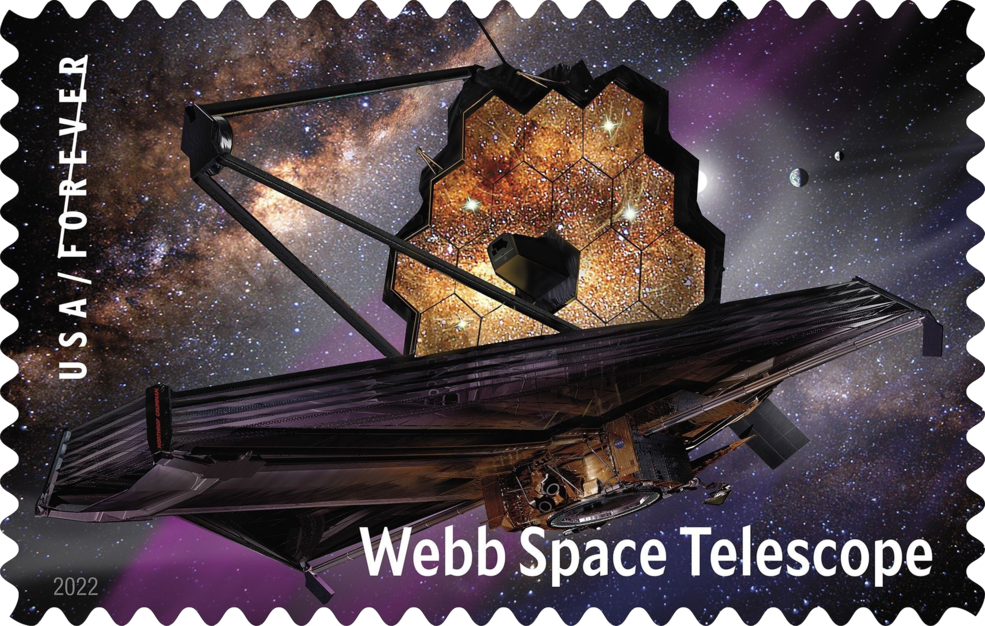
The U.S. Postal Service’s new stamp featuring NASA’s James Webb Space Telescope. U.S. Postal Service Art Director Derry Noyes designed the stamp using existing art by James Vaughan and an image provided by NASA and the Space Telescope Science Institute. Courtesy of the U.S. Postal Service.
Specializing in infrared observations—longer wavelengths for which Hubble had minimal capabilities—the Webb telescope is expected to study the most distant objects from Earth, allowing us to glimpse the origins of our universe, as well as planets orbiting stars in other galaxies.
Webb’s first cache of images caused a media sensation, and have since inspired an official postage stamp from the U.S. Postal Service, announced earlier this month.
Here are the latest views of the universe as seen through Webb’s high-powered lens.
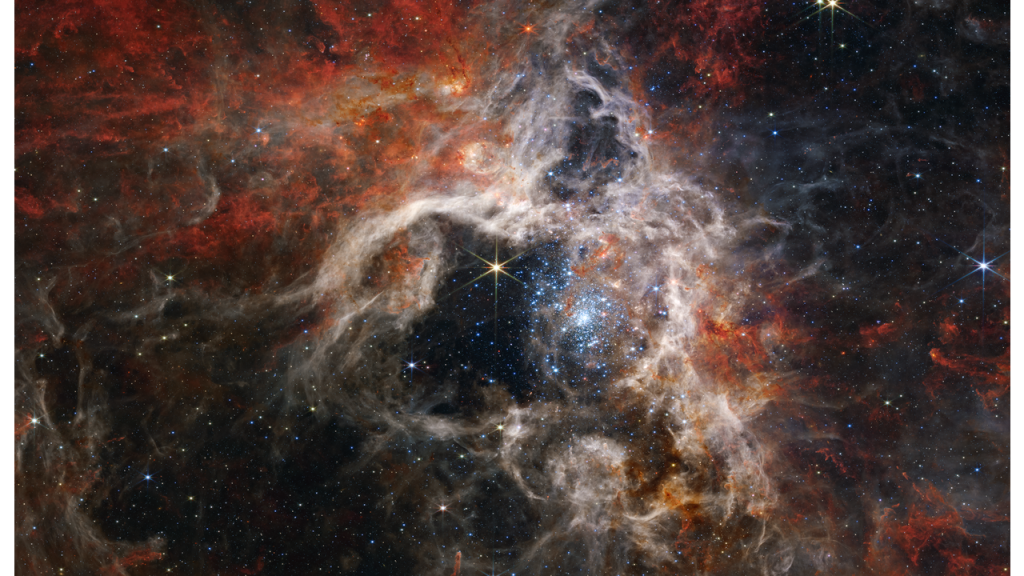
Webb’s Near-Infrared Camera (NIRCam) displays the Tarantula Nebula star-forming region. Courtesy of NASA, ESA, CSA, STScI, Webb ERO Production Team.
Some 159,800 light-years distant sits the Tarantula Nebula, or 30 Doradus, a stellar nursery where new stars are flickering to life amid gas clouds. Thanks to its near-infrared capabilities, Webb was able to capture star formation-in-action in unprecedented detail.
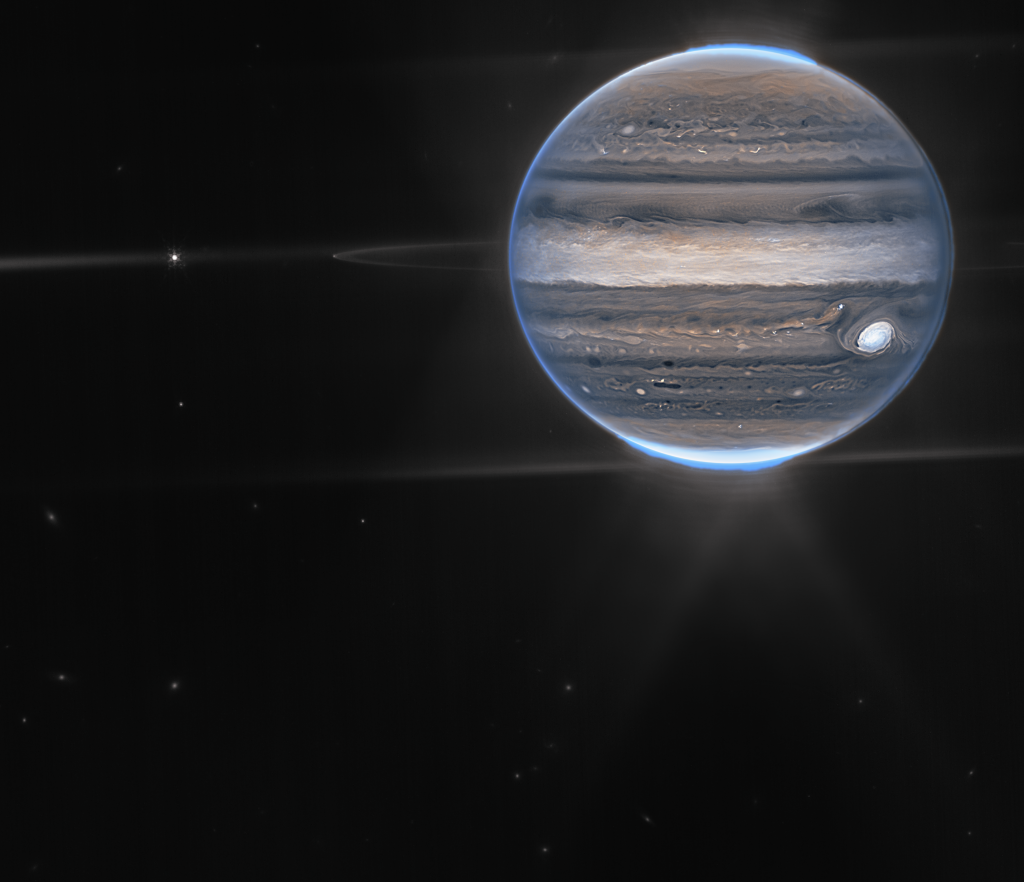
Webb NIRCam composite image from two filters – F212N (orange) and F335M (cyan) – of Jupiter system. Courtesy of NASA, ESA, CSA, Jupiter ERS Team; image processing by Ricardo Hueso (UPV/EHU) and Judy Schmidt.
Webb outdid itself with this dramatic view of the biggest planet in our solar system and its aurora, plus the distant galaxies beyond. “This one image sums up the science of our Jupiter system program, which studies the dynamics and chemistry of Jupiter itself, its rings, and its satellite system,” Thierry Fouchet, of the Paris Observatory, who co-led Webb’s observations of the planet, said in a statement.
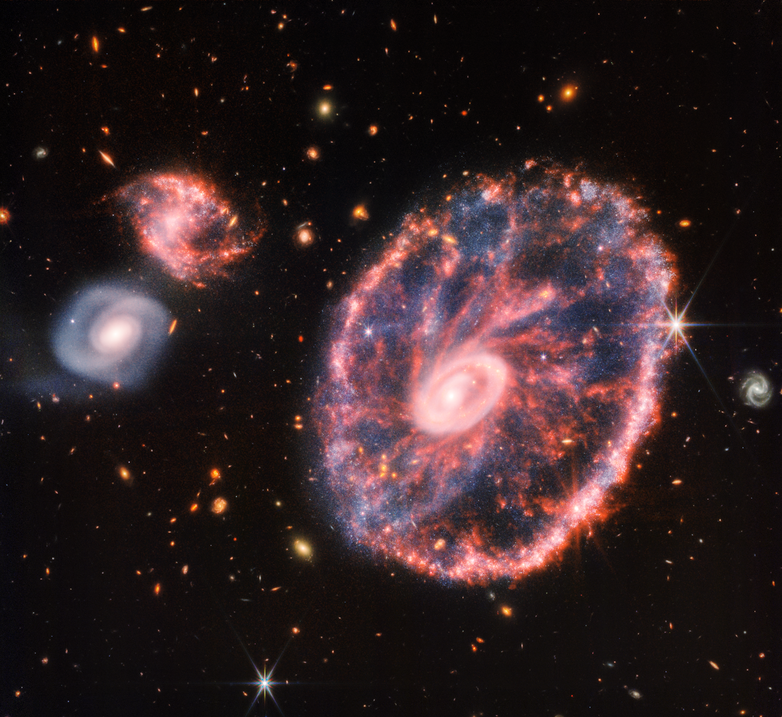
The Cartwheel Galaxy, located 500 million light-years away in the Sculptor constellation, and surrounding galaxies, as observed by Webb. Courtesy of NASA, ESA, CSA, Webb ERO Production Team.
The dramatic, wagon wheel-like appearance of the Cartwheel Galaxy, captured here by Webb, was likely caused by an interstellar collision with a smaller galaxy that crashed through the center and moved on. (It can’t be seen in this shot.) Located about 500 million light-years away in the Sculptor constellation, the Cartwheel Galaxy was presumably a normal spiral galaxy before its transformation. Observations by Hubble were obscured by gas clouds, which Webb’s infrared sensing capabilities were able to penetrate, providing a clearer view.
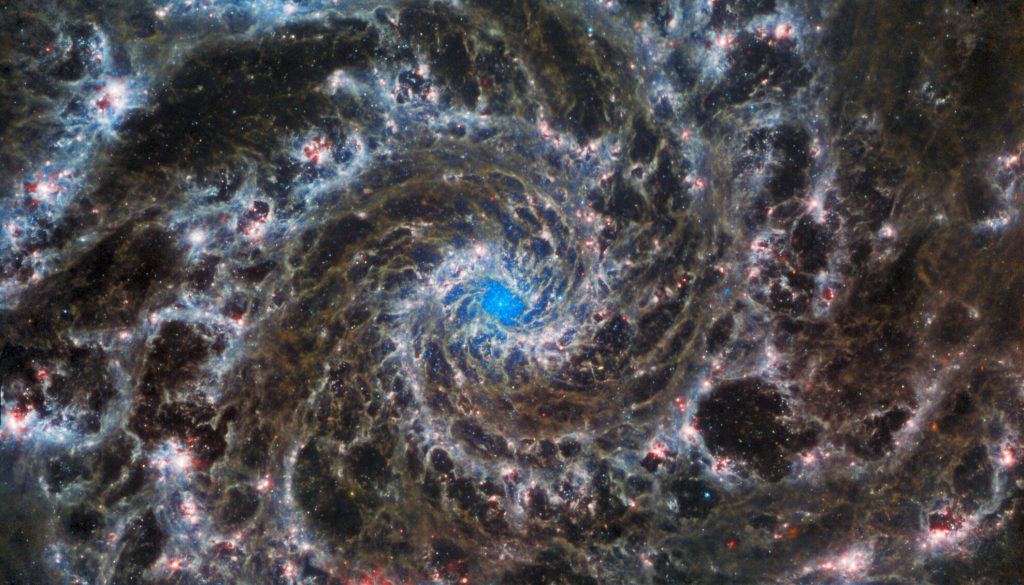
This image from the NASA/ESA/CSA James Webb Space Telescope shows the heart of M74, otherwise known as the Phantom Galaxy, with an unobscured view of the nuclear star cluster at its center. Courtesy of ESA/Webb, NASA & CSA, J. Lee and the PHANGS-JWST Team. Acknowledgement: Judith Schmidt.
Schmidt also had a hand in a new view of the Phantom Galaxy, a spiral galaxy around 32 million light-years away from Earth in the constellation Pisces, taken by Webb. “When I am in an ESA acknowledgement, it means they used the same or similar color mapping that I did, or were inspired by my work in their own processing,” she wrote on Twitter. The ESA also combined the new infrared Webb image with a shot taken by Hubble to provide more complete data in a combined view.
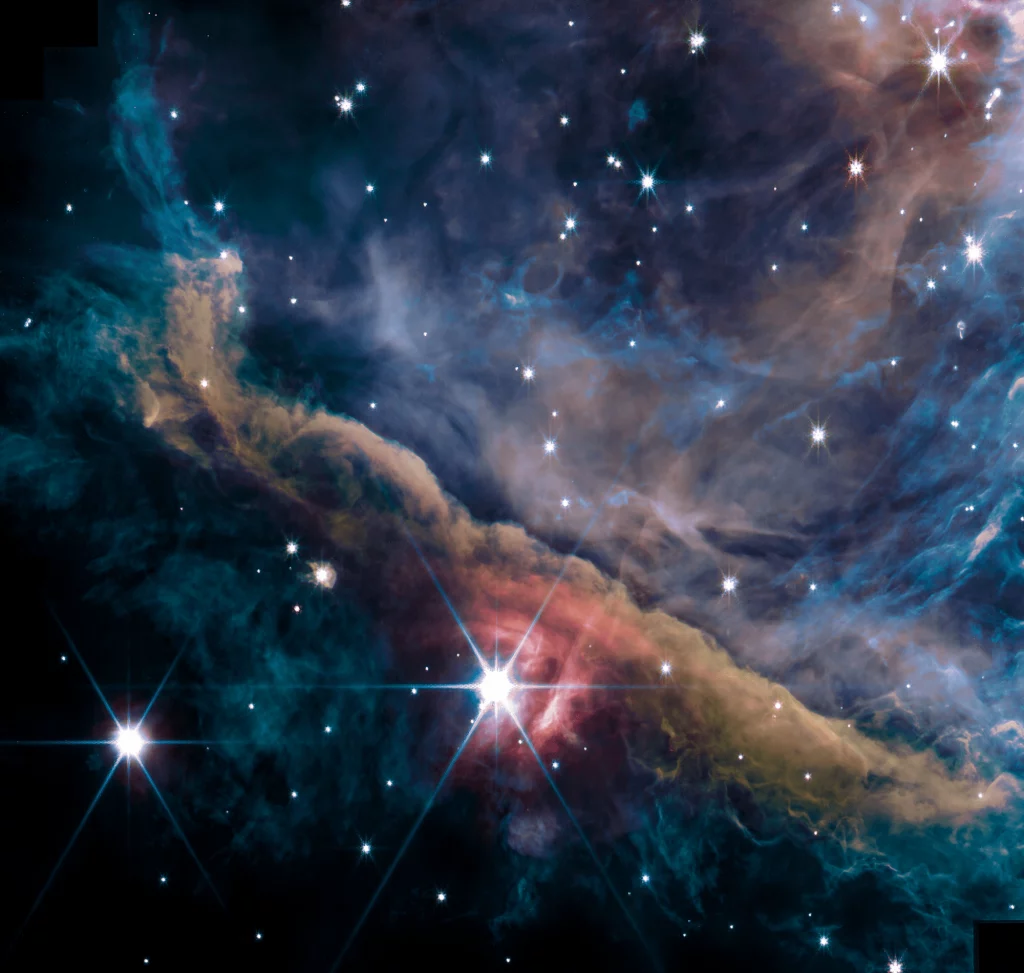
The inner region of the Orion Nebula as seen by the James Webb Space Telescope. Courtesy of NASA, ESA, CSA, PDRs4All ERS Team; image processing Salomé Fuenmayor.
This image of Orion, another star-forming region, this one 1,350 light-years away, hasn’t yet been released by NASA, as it was processed through an international collaboration including researchers from Ontario’s Western University. “We are blown away by the breathtaking images of the Orion Nebula,” Western astrophysicist Els Peeters said in a statement. “We started this project in 2017, so we have been waiting more than five years to get these data.”